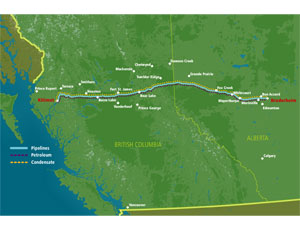The engineering manager for a major petroleum pipeline proposal now before Canada’s National Energy Board says project design and construction will mean significant earnings potential for engineering consultants and contractors. Ray Doering, Calgary-based Enbridge Inc. head of regulatory engineering and design, says the preliminary engineering process alone for the Northern Gateway oil pipeline between Alberta and British Columbia would involve “a whole range of different specialty consultants”, including those that would assess associated marine, geotechnical and constructability issues.
“Just in that design phase, where we’re collecting and assessing data to support the detailed design, we’re looking at in excess of $200 million,” says Doering.
Total cost of the 728-mile pipeline—which would transport petroleum and condensate in twin lines from Bruderheim north of Edmonton to the port of Kitimat—is pegged at $5.5 billion, partly targeted to materials procurement, equipment purchase and construction. By far the largest portion, however, would go to workforce wages; calculations regarding labor during construction account for approximately $4.3 billion of the entire project cost and nearly 63,000-person years of employment.
Enbridge’s first task is to convince the federal government of the project’s viability while allaying local concerns about its environmental impact. One section of particular concern is a proposed tunnel crossing at the sensitive Morice River in B.C.’s northern interior, upstream from spawning habitat for steelhead, pink, chinook and coho salmon. Because of those concerns, Enbridge is leaning towards directional drilling, “a well-proven method,” says Doering, “for pipeline crossings of watercourses.”
“The appropriate geotechnical conditions must first be confirmed to determine if the technique is viable... When it is verified, this crossing method is preferred where there are particularly sensitive fish spawning concerns or fish habitat areas that must be avoided.”
Modern pipe-design standards, materials and coatings, rigorous inspection techniques and the increased use of remotely-operated isolation valves all serve to protect the environment, Doering added. “No (liquids) pipeline constructed in Canada in the last 30 years has experienced a pipeline rupture. So I think that’s testament to the rigor and the quality of the installation processes that we see now.”
The Northern Gateway Pipeline is currently in the midst of a two-year regulatory review. If approved, construction would begin 2012 and be completed in 2016.


Post a comment to this article
Report Abusive Comment